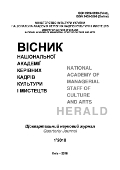LEGAL CHALLENGES OF THE PFRINCIPLE 45 OF THE IRANIAN CONSTITUTION
DOI:
https://doi.org/10.32461/2226-3209.1.2018.177675Анотація
Abstract. This paper focuses on the situation of public property and public ownership in the current Iranian Constitution, mainly in principle 45. There is also an extensive discussion on Islamic terms that are employed in the principle. The author discusses ambiguities, misunderstandings and legal challenges of the words and terms employed in this principle that move the principle far from a clear explication of specific principles. The paper aims to explore the defects of this principle explicitly, and provides suggestions to improve it.
Key words: Iranian Constitution, Principle 44, Anfal, Mobahaat, Public property.
Посилання
Assistant Professor in Islamic Azad University, Branch North Tehran, Law department
The Constitution of the Islamic Republic of Iran was adopted by a referendum on October 24, 1979, and came into force
on December 3 of that year, replacing the Constitution of 1906. However, the new constitution was amended on July 28,
The new Constitution contains a preamble outlining a broad ideological vision for the nation as a whole, 14 chapters
and 177 principles.
Pakistan Constitution 1973, Principle 227
Afghanistan Constitution 2004, Principle 3
From one point of view, one may raise a question that constitutions containing such a clause will inevitably prevent a
country from realizing democracy or from respecting liberal rights.
The Holy Quran, Sura Anfal, Verse 1
There are different views regarding the exact numbers of Anfal. Some Islamic writers say Anfal includes 7 types of
, page44), some believe it 2004properties (Zanjani, Amid, Political jurisprudence, 4 th volume, Amirkabir publication,
includes 11 types of properties (Shams, Ahmad, Legal regime of nationalized lands, 3th edition, Dadgostar publication,
, page 50), and some believe it includes 12 types of properties (Khamenei, Mohammad, Public ownership, Tak
publication, 1991, page 75)
In general, Imam, in Islamic terms, means Islamic leadership position. The term is most commonly used as the title of a
worship leader of a mosque or Muslim community who may lead that community and provide some religious guidance.
However, Shia Muslims believe that this term is dedicated for successors of Mohammad (Prophet of Islam). Shia consider
Ali as the one who divinely appointed by Mohammad as the first successor and as the first Imam. This term is extended to
Muhammad's family who is so called Ahl-albayt. According to this belief, there are 12 Imam who are divinely appointed
after Mohammad. There are also some slight differences between some schools of thoughts among Shia Muslims regarding
the number of Imams.
Tabatabai, Mohammad Hossein, Tafsir Almizan, Dar Al kotob Al Eslamieh Publication, 1991, pages 5&6
For more information see: K.Baslar, The concept of the common heritage of Mankind in International Law, Martinus
Nijhoff Publisher, 1998, pages 40&41
N. Katouzian, Property and ownership, Mizan publishing, 18 th ed, 2007, page 9
Iranian Civil Code 1928, article 27
In most Common Law systems and in the mixed jurisdiction of Scotland, if there are no surviving relatives, the estate
goes to the Crown. This estate is known as bona vacantia. See for more information: Carey-Miller, DL. & Irvine, D.
(2005). Corporeal Moveables in Scots Law (second edition), W.Green, 42
##submission.downloads##
Номер
Розділ
Ліцензія
Автори, які публікуються у цьому журналі, погоджуються з наступними умовами:
1. Автори залишають за собою право на авторство своєї роботи та передають журналу право першої публікації цієї роботи на умовах ліцензії Creative Commons Attribution License International CC-BY, котра дозволяє іншим особам вільно розповсюджувати опубліковану роботу з обов'язковим посиланням на авторів оригінальної роботи та першу публікацію роботи у цьому журналі.
2. Автори мають право укладати самостійні додаткові угоди щодо неексклюзивного розповсюдження роботи у тому вигляді, в якому вона була опублікована цим журналом (наприклад, розміщувати роботу в електронному сховищі установи або публікувати у складі монографії), за умови збереження посилання на першу публікацію роботи у цьому журналі.
3.Політика журналу дозволяє і заохочує розміщення авторами в мережі Інтернет (наприклад, у сховищах установ або на особистих веб-сайтах) рукопису роботи, як до подання цього рукопису до редакції, так і під час його редакційного опрацювання, оскільки це сприяє виникненню продуктивної наукової дискусії та позитивно позначається на оперативності та динаміці цитування опублікованої роботи.

